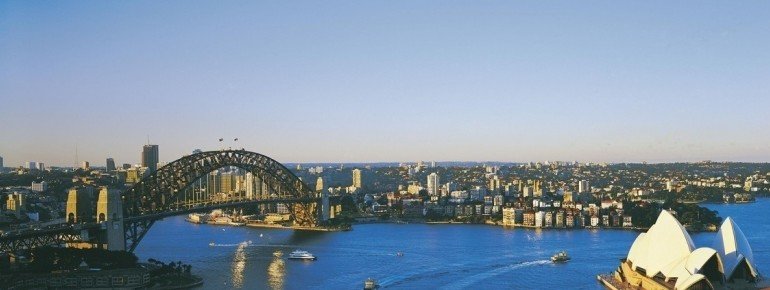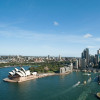Contents
Description
Sydney Harbour is renowned to be one of the most beautiful natural harbours in the world and is a must see when here! The harbour is 240 km (149 mi) long and genuinely an adventurous water park. On the edge of the harbour, there are plenty of sailing boats to rent, but also cultural sights as well as national parks and world heritage sites.
Sights
Without a doubt, Circular Quay is the core of Sydney's harbour and that not without a reason. Starting at the ferry terminal, located on the outskirts of Sydney, you may take a ferry to the separate segments of the harbour during daytime as well as to the suburbs located nearby the shore. Circular Quay is a collection point for (water-) taxis, boats, buses and trains. On the way to the “The Rocks”, a Sydney district, you find both the Museum of Contemporary Art and the Customs House located.
Two of the probably most famous landmarks of Sydney are its Opera and the Royal Botanical Gardens. You can get here on foot coming from Circular Quay. Stopping by at any of the restaurants, you will certainly get to enjoy a perfect view on Sydney's other landmark: Sydney Harbour Bridge. The locals call the bridge just “coat hanger”. While being a listed construction, it moreover stands for a modern Sydney and its future. If you have no fear of heights, you have the possibility to even climb the bridge and enjoy the spectacular view one has from up there. Inside the botanical gardens you find the Mrs Macquarie's Chair rocks, which also allow a fantastic view on the opera and the bridge. Regardless of landmarks and sights, you should come here anyway and have a look at the rare and special plants that are shown on-site.
The Sydney Harbour Circle Walk is the perfect place to flee your everyday life. You may walk it along the coast from the western point of the bridge up to Hunters Hill. Additionally, you may go on a stunning tour by water plane, overviewing the entire beauty of Sydney Harbour from the air.
Provided you are eager to see the unique fauna of Australia, you have many possibilities to choose from. You may stay overnight in a quarantine station or you visit the following marvellous sights: Taronga, Wildlife Sydney Zoo or Sydney Aquarium.
Last but not least, one mustn't forget the culinary highlights and fantastic restaurants that Sydney has to offer.
A Water Exploration Tour
The best way to discover Sydney is still on water. It doesn't really matter whether you are up for exploring uninhabited islands by ferry or by kayak or visit Cockatoo Island, which lies amidst the harbour, and spend a night here in a tent. Alternatively, you travel all different bays by using a sailing boat or a water taxi, respectively. Anyone will find something to their taste here. And if all that is nothing for you, you may think about the option to stay overnight in a luxury yacht.
Events
All over the place, in and around Sydney Harbour, there are plenty of events taking place on a regular basis. Ranging among the major ones are Vivid Festival, during which all houses located in the city centre are lit up, New Year's EveFirework, Australia Day and the beginning of the “Sydney to Hobart” yacht race. These major events are crowd pullers. Make sure you place yourself at the right position early enough to have a fantastic and hopefully first row view on everything happening.
Historical Information
Sydney is the capital of Australian federal state New South Wales and is the country's largest city with a population counting 4.63 million inhabitants. The city itself was founded on 26 January 1788 and is nowadays both a very popular tourist destination and a hub for industry, trade and finances. Furthermore, world renowned universities, galleries and museums can be found here. The metropolitan region is subdivided into 40 separate administrative districts, among which the most known ones are Bankstown, Botany Bay, Canterbury, Hunter's Hill, Liverpool, Sutherland, Sydney and The Hills.
It's noteworthy to add that inhabitants of Sydney are called “Sydneysiders”.
Geographical Location
Geographically, Sydney is located at the east coast and lies approximately 3 metres above sea level, the Pacific being the adjacent ocean. The urbanised area is about 1,664 km² (166,400 ha) large, whereas Sydney as metropolitan region encompasses a total surface of 12,000 km² (1200000 ha). The area starts at Hawkesbury River in the north and stretches all the way up to Botany Bay in the south. In the west, the area extends from Blue Mountains up to the Pacific in the east.
Historical Background
Before Captain James Cook discovered Botany Bay in 1770, the place we call Sydney nowadays was already inhabited by the indigenous Aborigines. Archaeological excavations in the Blue Mountains present artefacts and finds dating back to 20,000 years ago.
On 18 January 1788, Captain Arthur Philip arrived at Botany Bay that was henceforth used as a penal colony. While on an exploratory trip through Port Jackson, he accidentally discovered a bay on the other side which he then called “Sydney Cove”. This is where the city actually got it's name from.
In the beginning of the 19th century, streets, bridges, harbours and public buildings were constructed and paved the way for Sydney's further development from a former penal colony to a metropolis. In 1813, the pioneers succeeded in finding a way to the Blue Mountains, which had separated the colony from western Australia before. During the 1830s and 1840s the first suburbs were built. Along with the gold rush in 1851, Sydney flourished immensely in terms of culture, industry and trade. During the global economic crisis in 1931 Sydney experienced a huge economic collapse which many people were made redundant by. But only a year later the city had already recovered from the slump. In 1932 Sydney Harbour Bridge was constructed, connecting the northern part of Port Jackson with the rest of the city.
In 2001 Sydney experienced a drawback insofar as a bush fire destroyed large parts of the Royal National Park and the Blue Mountains.
How to get there
By Plane
Internationally well connected, the Kingsford Smith International Airport is situated approximately 14 km (8.7 mi) away from Sydney. Terminal T1 serves for international flights, whereas T2 and T3 are only for national flights. All three terminals are reachable via shuttle buses, the Airport Link and taxis of course.
By Train
The Airport Rail Link is the shortest connection from the airport to Sydney's city centre, taking only 15 minutes. It calls at all three terminals and operates between 5am in the morning until midnight, running every 10 to 15 minutes.
By Car
A further possibility to get from the airport to the city centre is to rent a car. Note that many Australian motorways charge tolls. The fees are invoiced electronically. It's worth getting informed about the Australian toll system before entering any motorway. As a visitor you may obtain an electronic pass at more than 300 outlets in New South Wales, each valid for 30 days.






















